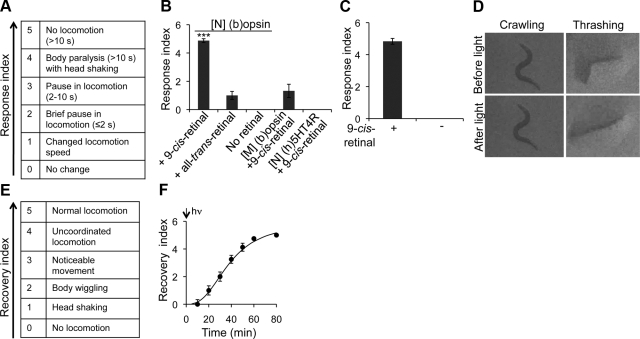Figure 2.
Worms expressing (b)opsin in neurons evidence a sudden transient loss of motility upon light exposure. A) Light-response index employed. B) L4 TG animals expressing (b)opsin in neurons ([N] (b)opsin) or muscles ([M] (b)opsin), and TG animals expressing (h)5HT4R in neurons ([N] (h)5HT4R) were preincubated with either 10 μM 9-cis-retinal ([N] (b)opsin, [M] (b)opsin, and [N] (h)5HT4R), all-trans-retinal ([N] (b)opsin), or no retinal ([N] (b)opsin) overnight and then transferred onto unseeded NGM plates (tracking plates). Vigorously crawling TG animals were then exposed to blue light (1000 lux, 488±20 nm) for 1 s. Light-responsive motor behaviors of these animals were recorded and scored according to the response index. Data were derived from 3 independent experiments with 5–10 animals each. C) Vigorously thrashing TG animals expressing (b)opsin in neurons pretreated with or without 10 μM 9-cis-retinal were exposed to 1 s of blue light (1000 lux, 488±20 nm). Light-response behaviors were recorded and scored. Data were derived from 3 independent experiments with 4–10 animals each. D) Vigorously crawling or thrashing TG animals expressing (b)opsin in neurons pretreated with 10 μM 9-cis-retinal were exposed to blue light (1000 lux, 488±20 nm) for 1 s. Images were obtained just before light exposure (top panels) and immediately (0.5 s) after light exposure (bottom panels). E) Recovery index employed. F) Vigorously crawling TG animals expressing (b)opsin in neurons and preincubated with 10 μM 9-cis-retinal were exposed to blue light (1000 lux, 488±20 nm) for 1 s. Locomotion recovery of initially motionless animals was then scored at times indicated. Data were derived from 3 independent experiments with 3–8 animals each. Error bars indicate means ± se. ***P < 0.01; 1-way ANOVA with Bonferroni correction.

